| |
| |
Photographer,
Location |
Images |
Comments |
| 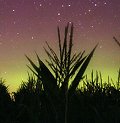
|
Tony Wilder,
Chippewa Falls, WI and EaglePoint, WI
Jul. 21, 2007 |
#1,
#2, #3,
#4 |
With
temps at 53 F in West Central Wisconsin, the crystal clear
cool skies allowed me to see a bright green halo glowing
off to my north starting at 10:15cst PM. Then a mild dance
started to occur so I grabbed my gear and out to the country
I went. I shot until 2am and again at 4am a slight glow
appeared. Auroras in the Summer! Christmas came 6 months
early this year.
Photo
details: Canon
30D, 50mm, f1.8 lens and SIGMA 17-75 f2.8 lens, ISO
1000, 28 seconds. |
|
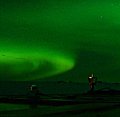
|
Chantal Steyn,
Sanae IV base,
Vesleskarvet,
Dronning Maudland,
Antarctica.
71 deg 40' S 2 deg 50' W
Jul. 15, 2007 |
#1,
#2, #3,
#4, more |
"We
waited almost a month for some auroral activity, and finally!"
says Chantal Steyn, a member of the South African National
Antarctic Expedition "wintering over" in Dronning
Maudland (Queen Maud Land) at a nunatak
named Vesleskarvet. "The temperature was -38o
Celsius when I took these pictures."
Photo
details: Sony
DSC-P93 digital camera, 400 ISO, 30s exposure
|
|
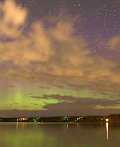
|
Tony Wilder,
Chippewa Falls, Wisconsin USA
Jul. 14, 2007 |
#1,
#2, #3,
#4, |
55o F and mostly
clear over Lake Wissota in Chippewa Falls, WI Saturday night
and a mild geomagnetic storm was glowing until at least
1am CST and then clouds blocked my view. Wisconsin at it's
best. What a treat to see the Northern lights again.
Photo
details: Canon
30D, 28 seconds, ISO 1600, f2.8 |
|
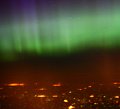

|
Doc Searls,
35,000 feet above northern Minnesota
Jul. 11, 2007 |
#1,
#2, #3,
#4, map,
more |
I was taking the redeye
from San Francisco to London when I looked out the window,
and got the treat that I seek every day in SpaceWeather,
but tend to miss because I live in Santa Barbara. The
aurora looked at first like clouds, and seemed to be only
yards away. Then I saw that indeed they were The Real Deal.
So I got out my Canon
30D with its cheap but excellent f1.8 50mm lens, and
shot away. ISOs range from 800 to 3600 (the Canon sensor
does very nicely in low light), with most at 800 or 1600.
Exposures ranged from one to 3.5 seconds, mostly at aperatures
from f3.5 down to f1.8. Longer exposures worked better for
colors, though of course risked more blurred motion with
stars. Holding still and blocking out light wasn't easy.
I made liberal use of the dark blanket provided by United
Airlines. The plane, for what it's worth, was a Boeing 777,
and my seat was 14a, near the front of the wing. More to
the story may be found here.
|
|
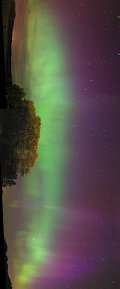
|
Stephane
Levesque,
Ste Luce, Quebec, Canada
Jul. 11, 2007 |
#1 |
I
saw the aurora alert on your site, then I saw a beautiful
display in my sky.
Photo
details: Pentax
Istdl2, 16mm, 1600 asa, 20s |
|
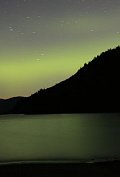
|
Andrew
Eaton,
Taken in Revelstoke, BC Canada
Jul. 11, 2007 |
#1,
#2 |
I
checked spaceweather.com too late and I missed most of the
show but caught this last bit of the display. |
|

|
Stephane Levesque,
Ste Luce, Quebec, Canada
Jul. 4, 2007 |
#1 |
The moon illuminated
the sky, but l could still see a little aurora borealis
this morning.
Photo
details: Pentax
Istdl2, 16mm, 800 asa, 20s
|
more
images: from
Ruth Ann Shuler of Helena, MT
|
|